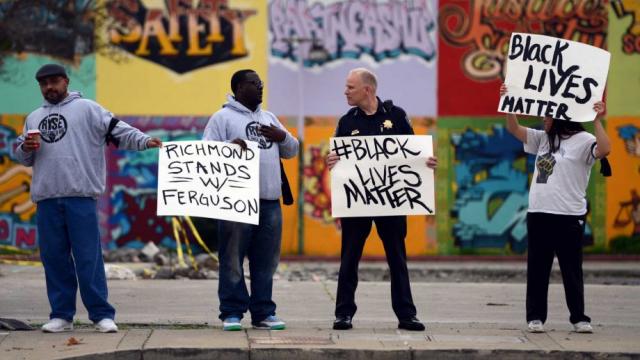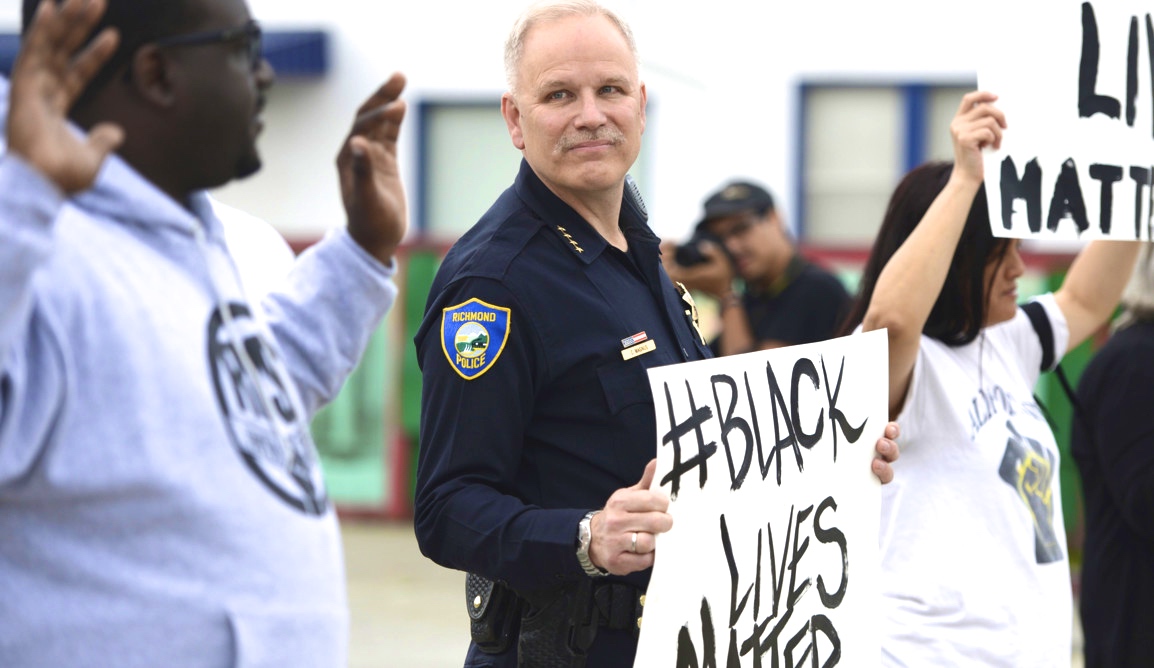
It seems each week brings new reports of police brutality and often fatal shootings in the United States. Police officials have even begun calling what used to be a “patrol” a “tour," as if American cities and towns are now war zones. This despite the fact that in the U.S. crime has declined substantially in recent decades. So isn't it time we asked: what policy options are available to build better bridges between police and the communities they're supposed to serve?
As it so often happens in America, certain jurisdictions in the state of California are leading the way with progressive solutions to the problem of overly aggressive and often militaristic policing. One is an initiative that emerged after the death of Santa Rosa eighth grader Andy Lopez at the hands of a Sonoma County Sheriff's Deputy in October of 2013. The other is an experiment in community policing that's been happening in the economically depressed Bay Area city of Richmond for a decade. For communities elsewhere seeking to reform and improve policing policies, perhaps the two cases can point a way forward.
Civilian Review Boards: The Case of Sonoma County
When 13-year-old Andy Lopez borrowed a replica AK-47 airsoft gun from a friend he was warned that the orange tip, mandated by federal law, had broken off and could get him into trouble with the police. He was carrying the toy on Oct. 22, 2013, when Sheriff’s Deputies pulled up behind him and, as we’ve seen far too often in recent years, the result was tragedy.
The all-volunteer, 21-member Community and Local Law Enforcement Task Force, formed after Lopez’s death, recently recommended the creation of an Office of the Independent Police Auditor to hold the Sonoma County Sheriff Department accountable for its interactions with the public.
Under the plan, attorneys who work in the Office would look into citizen complaints “and review allegations of police misconduct or excessive force, among deputies, jail, and probation personnel.” These kinds of civilian review boards have been tried successfully elsewhere in the country, including in nearby San Jose.
Unfortunately, in order to create the Office without having to go through an arduous political process, where powerful police unions and other groups might oppose it, the Task Force decided to create the body within already existing municipal laws. This was criticized by some activists because it means the Office won’t have subpoena power or the ability to issue indictments, and would have to rely on the Sheriff’s Department itself for access to internal documents relating to any particular case.
Related to this is the potential problem that the Office will need cooperation from the Sheriff, an elected position. Although the current Sonoma County Sheriff Steve Freitas has said he's open to the idea of an Independent Auditor, a change in leadership could mean that this proposed cooperation would end.
Separate from the recommendation to create the Police Auditor’s office, the Committee has made 20 other proposals as part of its ongoing work, including “Reviewing and recommending whether the Office of Coroner should be separately elected from the Office of Sheriff" – a suggestion so obvious as to be almost laughable, given how long such a conflict has existed.
Meanwhile, as the work in Sonoma County continues, the East Bay city of Richmond has been approaching reform from a different angle – with the impetus provided from within the police force itself.
Community Policing Works: The Richmond Model
Back in 2005, Chris Magnus probably didn’t expect to get the job as Chief of Police in Richmond, a racially diverse city of about 100,000 just north of Berkeley. That isn’t to say Magnus didn’t have a successful career; as one of America’s first openly gay police chiefs, he was already breaking down barriers in Fargo, North Dakota, his former command post. But Richmond and Fargo are very different places: Fargo had just two homicides in 2005 while Richmond, with a slightly smaller population, had 47.
At the time, Richmond politicians were ready to try something new, and they believed Magnus had the right ideas to help bring about changes in the culture of policing. When Green Party Mayor Gayle McLaughlin and the Richmond City Council hired him, Magnus undertook a radical re-structuring of the department’s practices and priorities, with a particular focus on weeding out bad apples and diversifying the force.
One of his first actions as Chief was to put an end to the tactic of using “street teams,” in which a number of officers were deployed in high crime areas to “roust anybody who’s out walking around, with the idea that they might have a warrant outstanding or be holding drugs.” This kind of big net approach, like “Stop and Frisk” policies elsewhere, makes the mainly law-abiding citizens in neighborhoods feel like they’re under siege, leading to a lack of trust on both sides.
The change was coupled with a policy designed to get officers to walk regular beats, a bulwark of community policing, and to stay in one area for a sustained period of time rather than transferring to a new area every year, a common practice throughout the U.S. Police were also encouraged to keep to regular routes for their patrols rather than constantly changing them.
What this meant in practice was that officers interacted more with the community, and citizens were able to find them to report problems. As one resident put it in a recent interview, “I’ve never been so comfortable with police. It’s like everything else, when you get to know a person you look at them differently.”
Another approach taken by Magnus was to work with non-profits and community groups, even controversial ones. One such group is the Office of Neighborhood Safety (ONS). The organization tracks 50 young people most at risk of being involved in a homicide, whether as victims or perpetrators. Once the necessary data is compiled, youth mentors, many of them from the same communities as the young people and most with similar backgrounds, locate them and offer them a space in a program that literally pays them to stay out of trouble.
While ONS has its critics, it has shown results that have led other municipalities across the country to pay attention. As of last August when Mother Jones did a story on the man who started the program, Devone Boggan, “65 of the 68 'fellows' enrolled in the program in the previous 47 months were still alive.” To be sure, paying at-risk youth anywhere from $300 to $1,000 a month (provided not by government but by private donors), and mentoring them to improve their future prospects, may hold little appeal to those who believe that punishment is the best way to change behavior. Chief Magnus’s willingness to work with ONS showed an open mind to dealing with crime, something generally outside the purview of law enforcement.
The overall homicide rate in Richmond has declined by about two-thirds during Magnus’s decade-long tenure. Perhaps even more heartening is the decline in officer involved shootings, which have averaged less than one a year since 2008 – and the fact that their were no fatal shootings in the city between 2007 and Sept. 14, 2014.
Rather than indulge in attacks on the character of Richard Perez III, the young man who was killed by Officer Wallace Jensen while allegedly resisting arrest last September, Magnus made the statement: “One of the things we tried to convey is that we have genuine sympathy for the family and acknowledge that the death of this young man is tragic.” Compare this to the reaction of police officials in Ferguson after the shooting last summer of Michael Brown.
After ten years of reform, Richmond has emerged as a success story in terms of community-oriented policing. Meanwhile, Chief Magnus continues to challenge the status quo, recently earning the ire of conservatives and even the Richmond Police Officers Association when he appeared in uniform at a demonstration against police brutality holding a sign that read #BlackLivesMatter.
When asked about the controversy, Magnus said: “When did it become a political act to acknowledge that 'black lives matter' and show respect for the very real concerns of our minority communities? This should not be about 'us versus them.' It should be about finding ways to build bridges and address the schism that exists between many of our residents and police.” Hopefully the kinds of solutions to police violence being pursued in Richmond and Sonoma County will be tried elsewhere, as the need for change in the way many police departments perform their duties has never been clearer.
3 WAYS TO SHOW YOUR SUPPORT
- Log in to post comments














